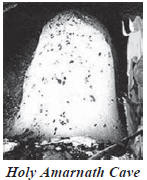Maliks of Kashmir
By
M.M. Munshi
None of
the features of Kashmir
have so directly
influenced its history as the
mountain ranges which
enclose it. For centuries the
mountain ranges guaranteed its
relative safety against foreign invasions
in comparison to plains of
the sub continent. The only
vulnerable points were the mountain
passes and Pakhla route
along the Jhelum valley.
 Throughout
the history special care was
taken by the rulers of Kashmir to
keep a strong hold on the
route entering and leaving the valley
and ingress was very
strictly controlled. It was probably
for this reason that muslim
rule in Kashmir was established about more
than three centuries
later than the adjoining Punjab and
other northern parts of
the sub continent that too not by
conquest. Mohmud Gaznavi
twice failed to penetrate Kashmir
via Toshmaidan Pass in 1015 and
1021 AD due to skilful deployment
of defending forces by
Kashmiris in the narrow glen of
Lohara present Lorarin. Throughout
the history special care was
taken by the rulers of Kashmir to
keep a strong hold on the
route entering and leaving the valley
and ingress was very
strictly controlled. It was probably
for this reason that muslim
rule in Kashmir was established about more
than three centuries
later than the adjoining Punjab and
other northern parts of
the sub continent that too not by
conquest. Mohmud Gaznavi
twice failed to penetrate Kashmir
via Toshmaidan Pass in 1015 and
1021 AD due to skilful deployment
of defending forces by
Kashmiris in the narrow glen of
Lohara present Lorarin.
Kalhana
mentions these entrances into the
valley as
Dvars Darangas.
The names
still survive to this
day in Biru and Hirpur areas of
Kashmir valley. During the muslim
rule the dvars came to be known
as
Kartals
or simply
Darras
(passes).
The
establishments of dvars
comprising watch cum
military stations
each of which was organised
on a feudal basis
under an official
called as
Dvarpati
or
Davarpida
who maintained
a contingent of militia
the size of
which depended on the
importance of the route,
capable of holding the
dvars
till
arrival of reinforcements. In subsequent
chronicles, Srivara referred the
dvarpatis as
margapati
and
marghesa.
In due
course of time the
Sanskrit term
margesa
was
distorted to Magrey both words
signifying profession. All the
descendants of Magres could not have
been employed for guarding
the routes/passes but they
continued to use the title even after
adopting other professions.
Those who
continued to guard the routes
/passes were bestowed by
independent Sultans of Kashmir the title
of honor and distinction
"Malik". However at different times
besides the guardians of
passes/routes leaders of influential groups
like Chaks,
Rainas, Dars and
others were also
bestowed with title
of Malik for
their loyal
services. After the
annexation of Kashmir
by Mughals in
1586 most of
the Chaks,
Magres and
other Maliks
were hunted,
killed and banished
from the valley for having fought
against them. But those who latter
submitted themselves before
Emperor Akbar and took the oath
of loyalty were allowed to assume
the duties of maintaining and
guarding the routes/watch stations,
administration as well as judiciary
on receipt of fresh grants of land.
During the
Afghan rule 1753-1918 all
the routes leading to Punjab and
other places except the Pakhli
route [which they needed for
communication with Kabul ] were
closed for travelers as well as trade
for security reasons .
Guarding
of certain routes was taken up
by Afghan army. After Sikhs
annexed Kashmir in 1819 all
the routes were reopened and
institution of Maliks was
revived but with reduced grant of
lands. Some of the Maliks
to supplement their reduced
grants of land started charging
very exorbitant tax of rasum
rahdari from traders and others for
which they were severely punished
by Sikhs.
With the
advent of Dogra rule in
1846 opening of the most of
the routes and gradual
establishment of regular police posts at
vulnerable places and reasonable
distances the ancestral occupation
of Maliks came to an end. During the later half of
nineteenth century the maliks had
to contend themselves by
escorting the pilgrims to
Amarnathji cave, Harmukh Gangabal
and probably to Sharda in
Kishenganga valley and other
places of pilgrimage for which
they received a fixed percentage
of the offerings at the shrine
rather than for rediscovering or
retracing the route to the
holy places like Amarnathji
Cave.
Source: Kashmir
Sentinel
| 